Makdous Al-Bathenjan
September 29th, 2017
This post is related to : Typical Syrian Breakfast
It is the season of vegetables that are main ingredients of many Syrian dishes, one example is Eggplant (Bathenjan in Arabic). It is the time to make Makdous Al-Bathenjan, Mrabba Al-Bathenjan, Mrabba Al-Bathenjan Al-Halabi, and Mkhallal Al-Bathenjan (eggplant pickle).
Makdous Al-Bathenjan is a traditional Syrian dish that goes back generations. It is prepared by stuffing baby eggplants with a mixture of chopped walnuts, ground red pepper, salt and garlic and preserved in olive oil. It is normally eaten with Arabic flat bread as part of the breakfast or supper, or as a snack. Makdous is best made at home.
Let’s make Makdous Al-Bathenjan:
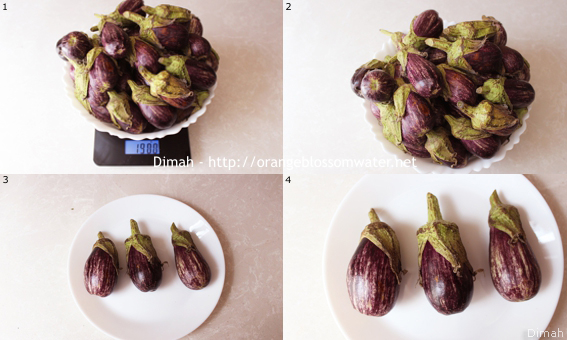
1, 2, 3, 4. These are baby eggplants, and this is the type of eggplants used for making makdous (try to find the same kind in the picture), approximately 1 1/2 – 2 inches long (4 – 5 cm).
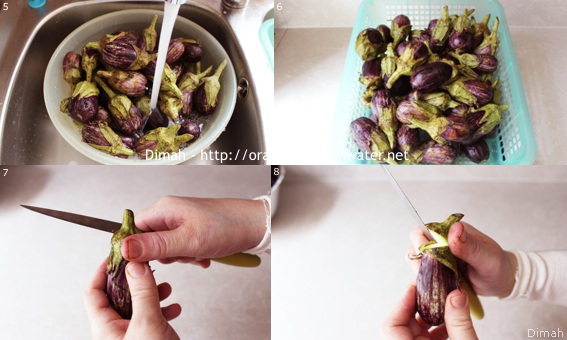
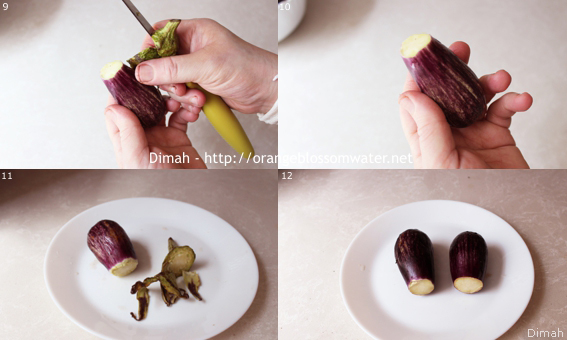
5, 6. Rinse eggplants with water, then put in a colander to drain.
7, 8, 9, 10, 11. Cut off the cap and the stem.
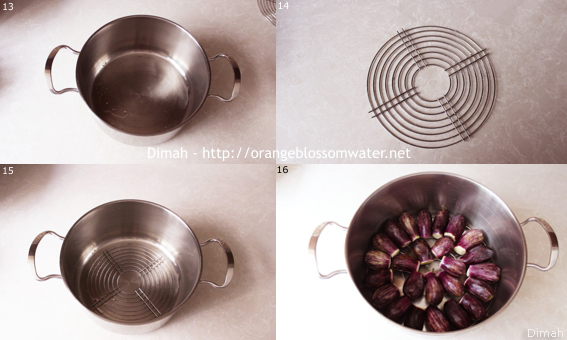
13, 14, 15. Prepare a large deep pot, and put a round cooling rack at the bottom of the pot. The round cooling rack works as a protection for the eggplants; to prevent the direct contact between the eggplants and the heat.
16. Arrange eggplants as you see in the picture.
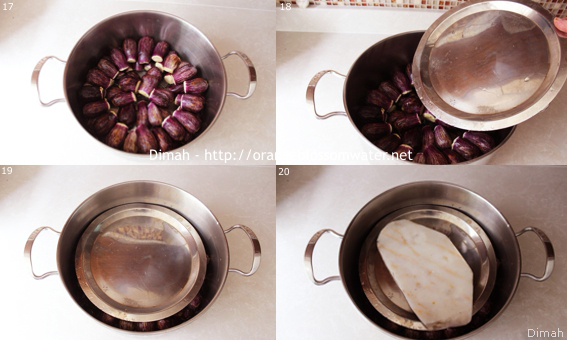
17, 18, 19. Put a flat lid over the stuffed eggplants.
20. Put a weight over the plate, this is a piece of marble.
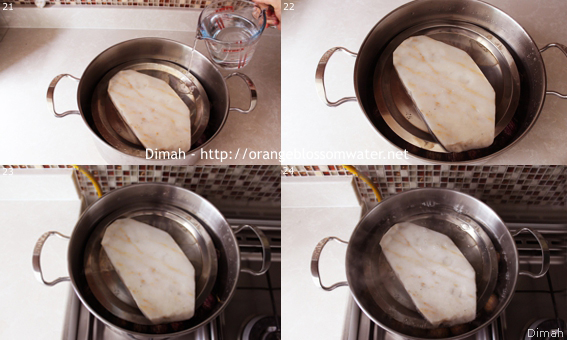
21. Add water to the pot to cover the eggplants.
22. Water should be above the top level of the eggplants.
23. Turn on heat and keep over high heat until it starts to boil vigorously.
24. Reduce heat and simmer over low heat for 25 minutes then turn off heat. The time varies according to the size of the pot, the size of eggplants and the amount of eggplants.
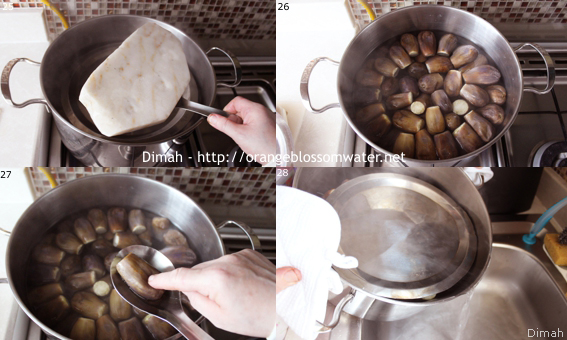
25. Remove the heavy weight.
26, 27. Eggplants should be soft but not mushy. Check by pressing the eggplant with your finger and it should leave a mark. If the eggplants still hard, so you may need to simmer for some extra time.
28. Drain water from eggplants.
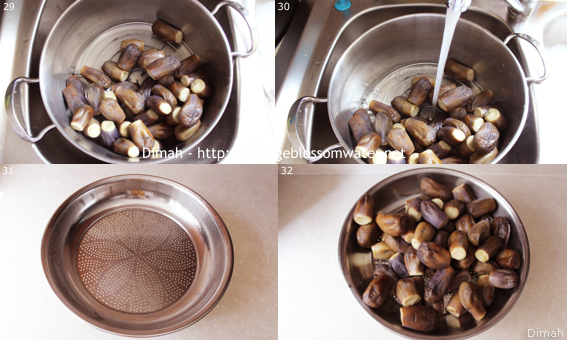
29, 30. Cover eggplants with cold water for 10 minutes.
31, 32. Put a strainer over a bowl, and put eggplants on strainer and set aside to drain.
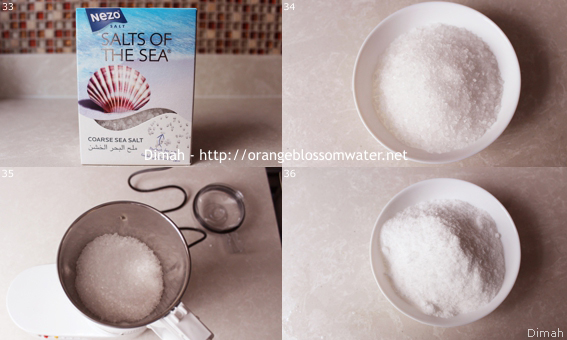
33, 34, 35, 36. The salt used for Makdous should be sea salt or rock salt and not iodized. Use medium coarse sea salt, but if it is extra coarse or flakes, use a spice grinder as I did and grind into powder “but not too fine powder”.
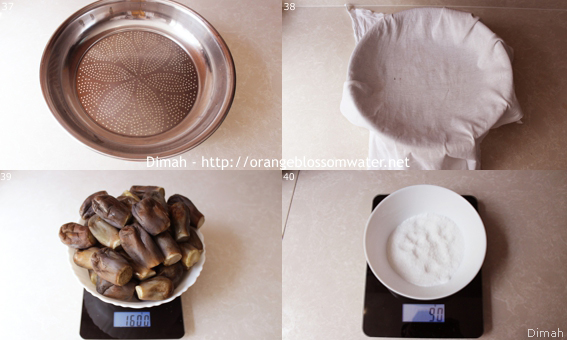
37. Put a strainer over a bowl.
38. Line the strainer with a clean cotton cloth, and set aside.
39. The weight of eggplants after boiling is 1600 g.
40. Measure 90 g salt.
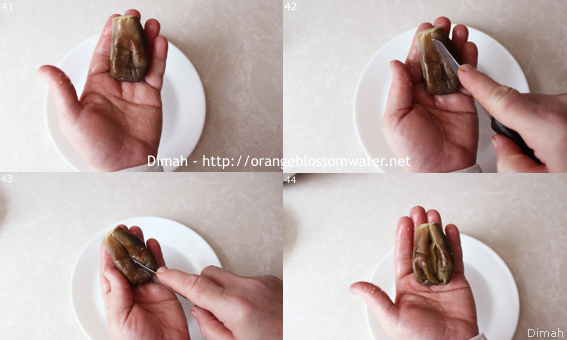
41, 42, 43, 44. Create a small vertical opening in the middle of the eggplant.
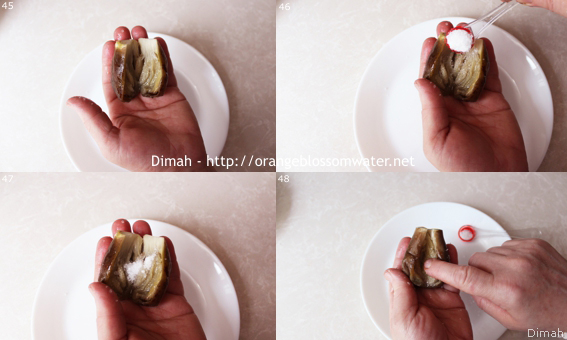
45, 46, 47, 48. Stuff each eggplant with 1/8 teaspoon of salt and rub the salt.
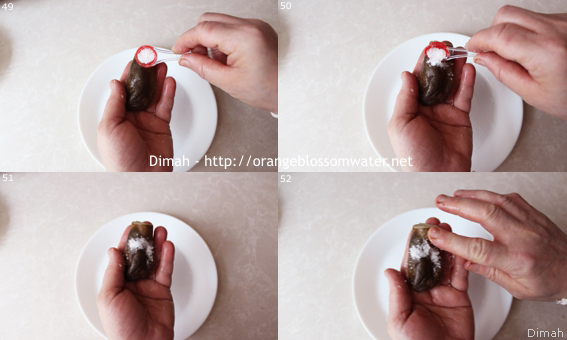
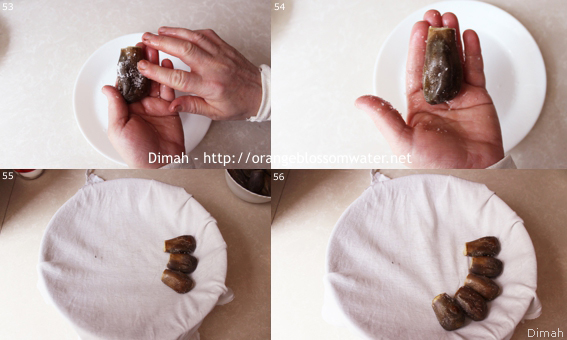
49, 50, 51, 52, 53, 54. Rub the outside of each eggplant with another 1/8 teaspoon salt. So the total amount of salt for each eggplant is 1/4 teaspoon, this is for a small eggplant. Bigger eggplants need 1/2 teaspoon salt.
55, 56. Arrange the eggplants on the cloth.
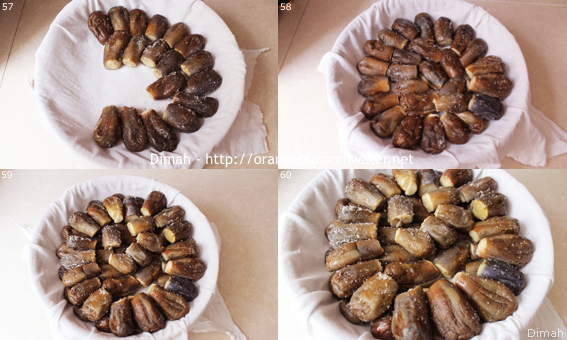
57, 58, 59, 60. Eggplants should be arranged in a circle. Arrange the first layer of eggplants on the cloth, then put another layer of eggplants, the maximum number of layers should be two only.
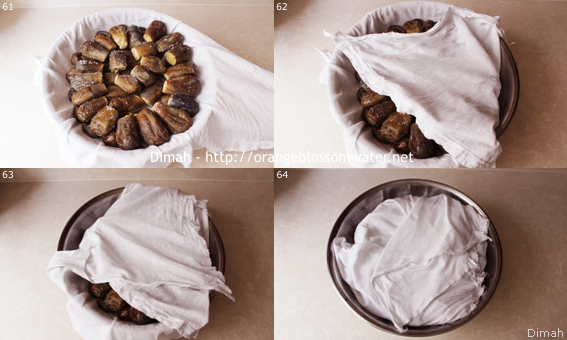
61, 62, 63, 64. Fold the cloth around the eggplants.
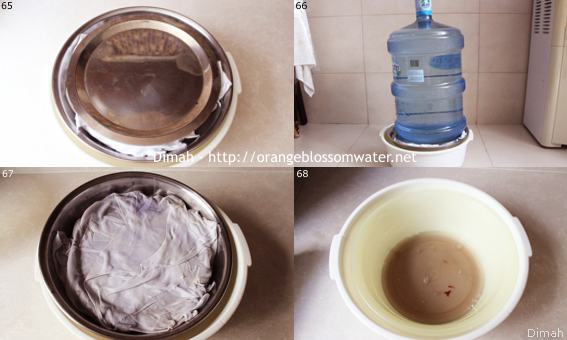
65, 66. Put a flat lid over the cloth, then put a weight on top which is 5 gallon water bottle. Set aside in a cool place for 6 hours.
67, 68. After 6 hours, check the eggplants. The cloth is moistened with water and the bowl contains water.
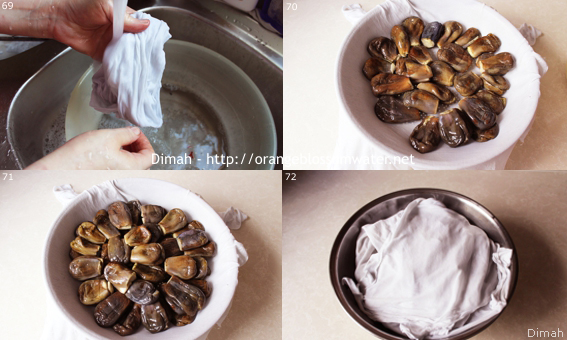
69. Rinse the cloth with water.
70, 71. Again line the strainer with the same cloth, arrange the eggplants on the cloth.
72. Fold the cloth around the eggplants.
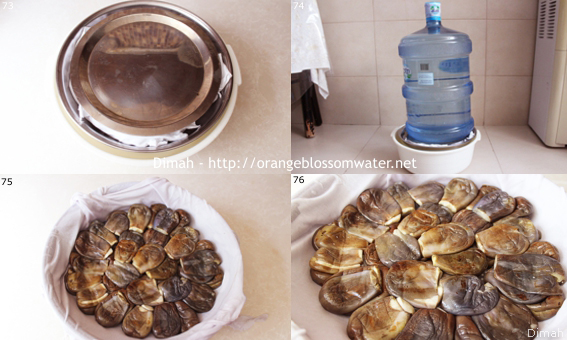
73, 74. Put the flat lid over the cloth, then put the weight on top which is 5 gallon water bottle. Set aside loaded in a cool place for 24 hours. During the 24 hours, check on the eggplants every 6 hours and repeat the above steps (rinse the cloth, line the strainer with the same cloth, arrange the eggplants on the cloth again and keep it with the heavy weight).
Time varies between 24 hours to 48 hours, the most important thing is to keep in a cool place and to make sure that the eggplants drained out all of their water. 24 hours were enough for me in this batch.
75, 76. After the above period, eggplants are pressed, free of water, and ready to fill.
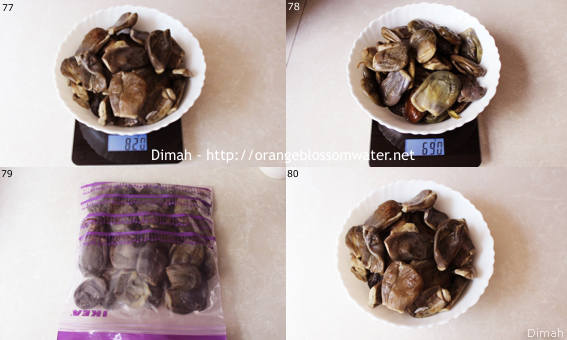
77. The weight of eggplants after pressing is 820 g.
78. I used 690 g of eggplants for this recipe.
79. I put the rest of eggplants in a freezer bag and store it in the freezer (read notes and tips).
80. Prepared eggplants for the filling.
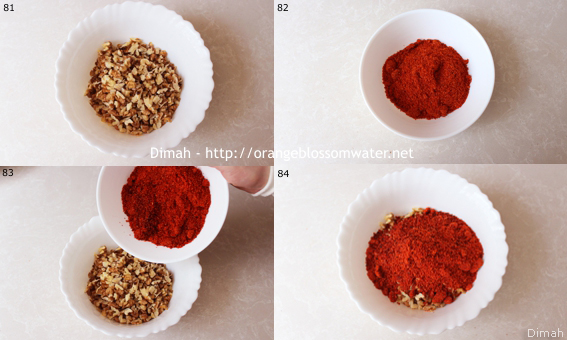
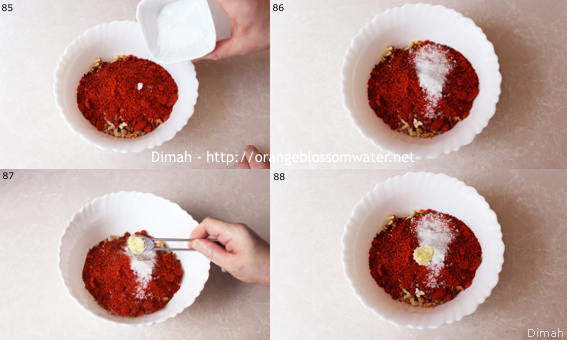
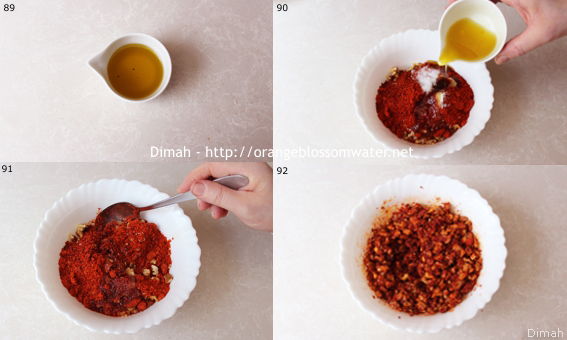
Filling
81. Put 150 g chopped walnuts in a bowl.
82, 83, 84. Add 50 g ground Aleppo pepper to chopped walnuts.
85, 86. Add 10 g salt (sea salt or rock salt but should be fine salt and not iodized).
87, 88. Add 1/2 teaspoon (3 g) crushed garlic. Garlic is optional.
89, 90. Add 3 tablespoons olive oil.
91, 92. Stir the ingredients to mix them.
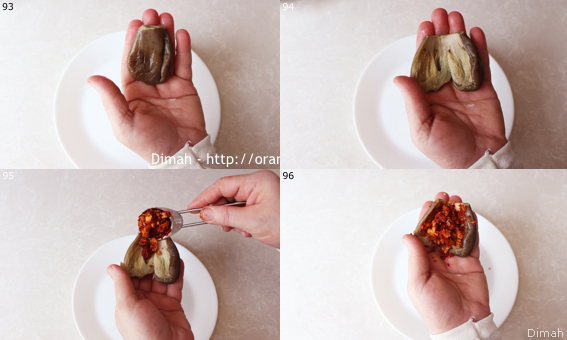
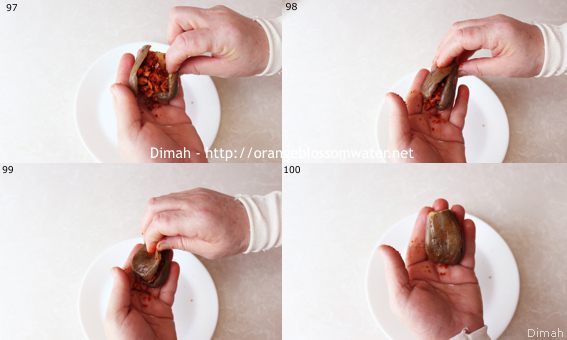
Making Makdous Al-Bathenjan
93, 94. Open the small vertical opening of eggplant.
95 to 100. Stuff each eggplant with 2 teaspoons filling. The amount of filling depends on the size of the eggplant.
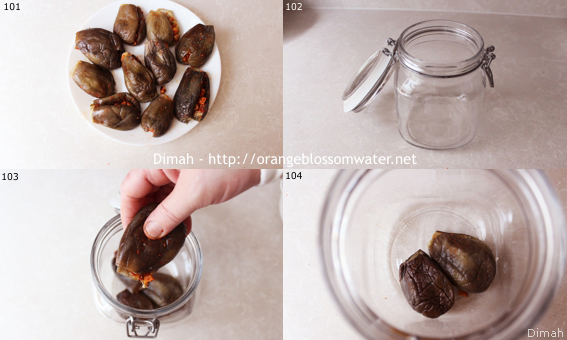
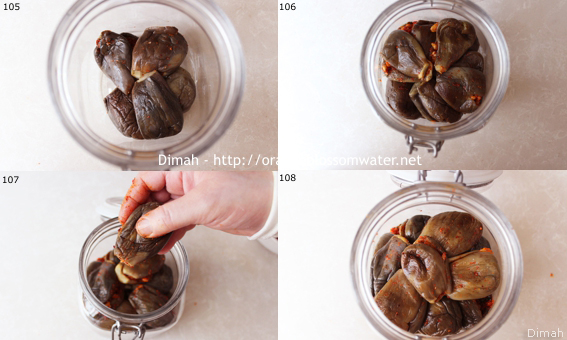
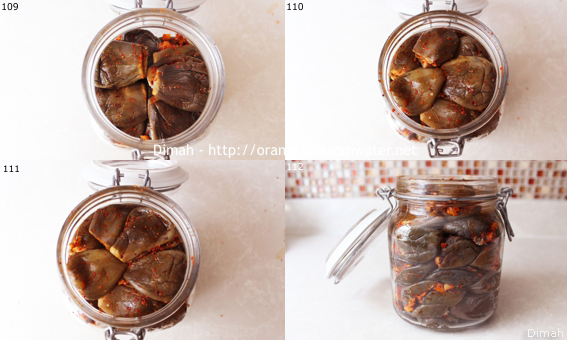
101 to 112. Arrange in a sterile airtight jar. This close picture to show you how you should arrange eggplants in jar, should be in the same way in the picture.
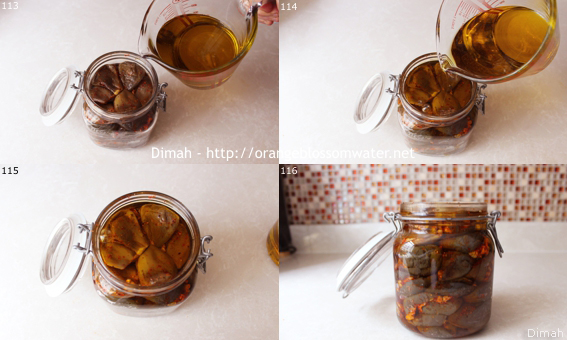
113, 114, 115, 116. Cover eggplants with olive oil.
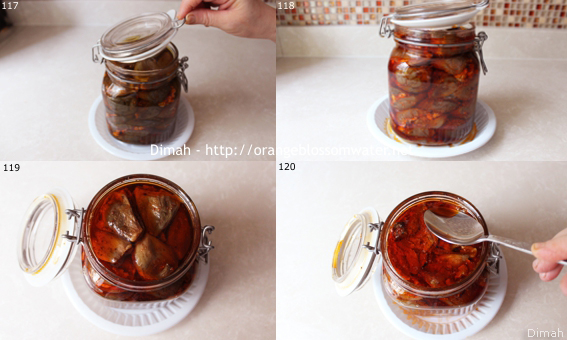
117, 118, 119, 120. Leave the jar partially opened, and keep at room temperature for 7 days. It is normal if olive oil overflows, use a spoon to gently push down the eggplants, this will release the air and will reduce oil overflowing, repeat this from time to time, then add olive oil when needed. Check occasionally and always keep eggplants covered with olive oil.
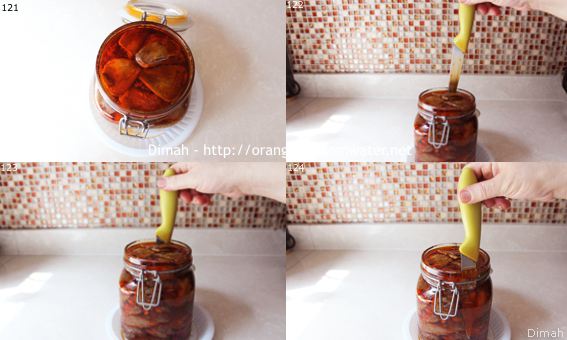
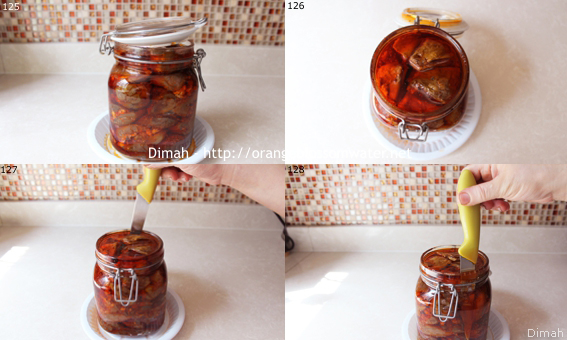
121 to 128. Use a knife and push on side of the jar to allow olive oil to penetrate.
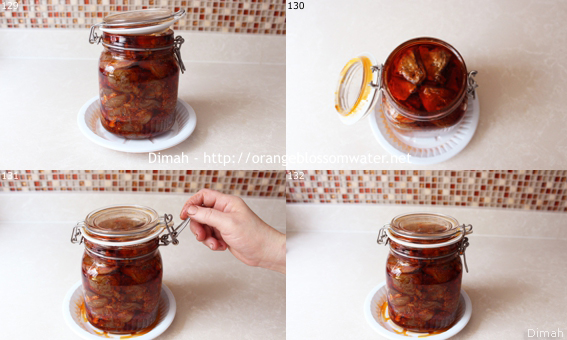
129, 130, 131, 132. After 7 day, makdous is ready for consumption. Seal the jar.
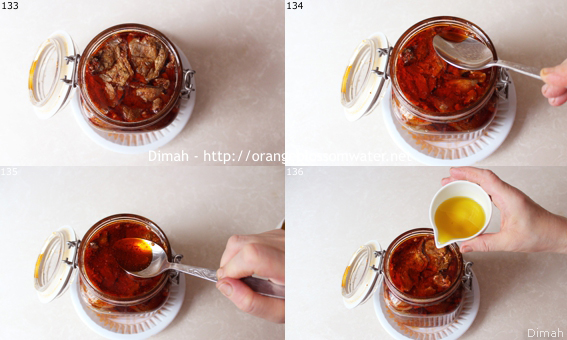
133, 134, 135, 136. The surface should be always covered with olive oil, use a spoon to gently push down the eggplants then add olive oil when needed. Check occasionally and always keep eggplants covered with olive oil.
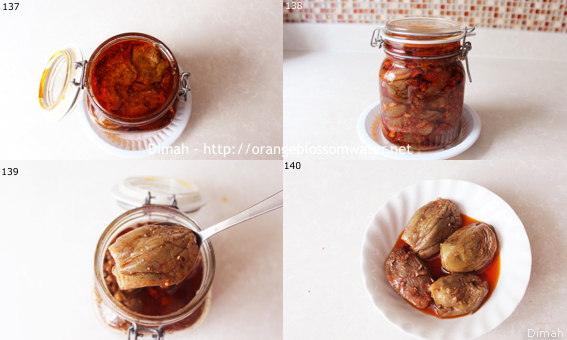
137, 138. Store in the refrigerator. You may keep it at room temperature for extra 3 days only (total 7 days + 3 days) and you can eat from it then store it in the refrigerator. The olive oil solidify in the refrigerator so bring makdous to room temperature before serving. Also after refrigerating, check occasionally and always keep makdous covered with olive oil.
139, 140. Serve makdous in a plate with olive oil.
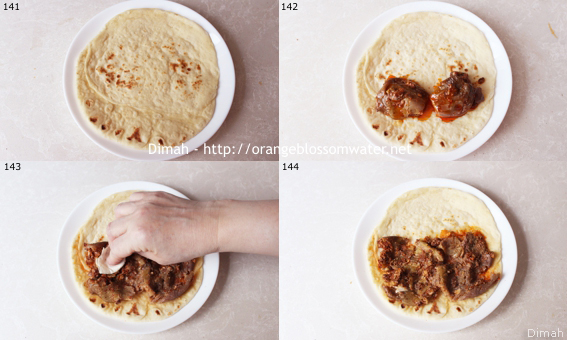
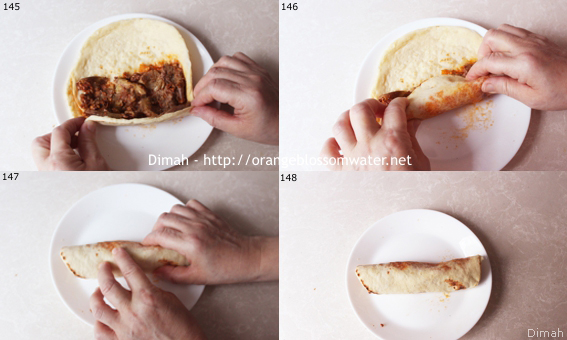
141 to 148. Bring Arabic flat bread, put makdous and use a piece of bread to crush into pieces. Wrap and serve.
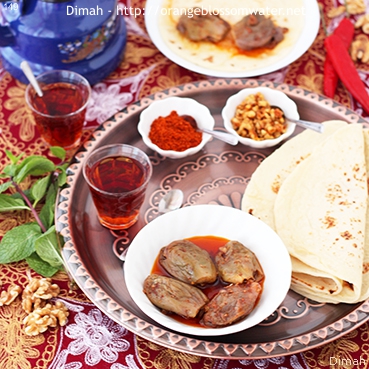
149. Serve Makdous Al-Bathenjan with Arabic flat bread and tea.
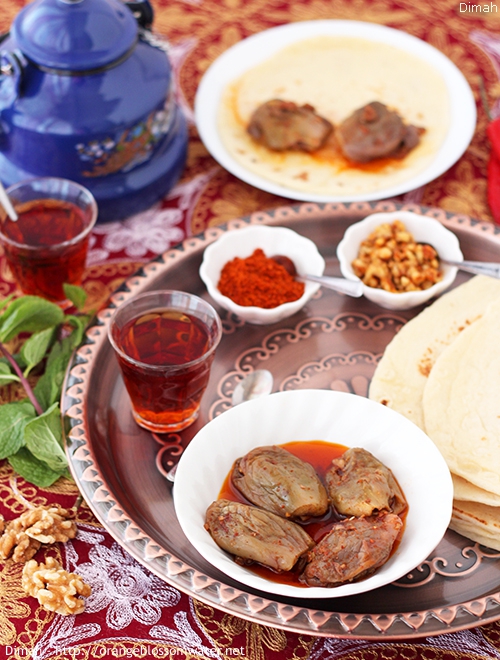
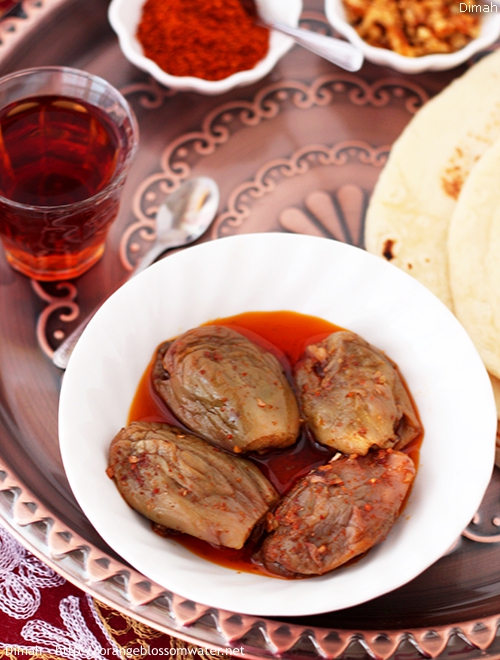
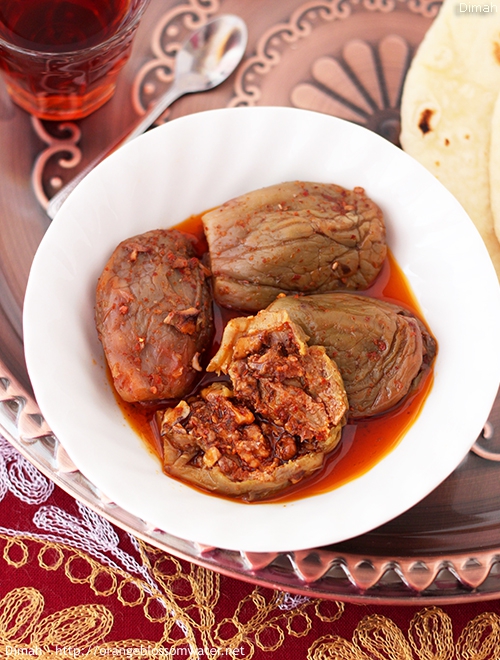
Makdous Al-Bathenjan
From: Family Recipe / Servings:
PDF Text Only / Print With Images
| 1900 g baby eggplants approximately 1 1/2 – 2 inches (4 – 5 cm) long Water, to cook eggplants 90 g sea salt or rock salt, read directions 690 g baby eggplants, weight after cooking and pressing Filling 150 g chopped walnuts, 50 g ground Aleppo pepper 10 g fine sea salt or rock salt, read directions 1/2 tsp (3 g) crushed garlic, optional 3 tbsp olive oil To Store + 300 ml olive oil To Serve Arabic flat bread Tea |
These are baby eggplants, and this is the type of eggplants used for making makdous (try to find the same kind in the picture), approximately 1 1/2 – 2 inches (4 – 5 cm) long.
Rinse eggplants with water, then put in a colander to drain. Cut off the cap and the stem. Prepare a large deep pot, and put a round cooling rack at the bottom of the pot. The round cooling rack works as a protection for the eggplants; to prevent the direct contact between the eggplants and the heat. Arrange eggplants as you see in the picture. Put a flat lid over the stuffed eggplants. Put a weight over the plate, this is a piece of marble. Add water to the pot to cover the eggplants. Water should be above the top level of the eggplants. Turn on heat and keep over high heat until it starts to boil vigorously. Reduce heat and simmer over low heat for 25 minutes then turn off heat. The time varies according to the size of the pot, the size of eggplants and the amount of eggplants. Remove the heavy weight. Eggplants should be soft but not mushy. Check by pressing the eggplant with your finger and it should leave a mark. If the eggplants still hard, so you may need to simmer for some extra time. Drain water from eggplants. Cover eggplants with cold water for 10 minutes. Put a strainer over a bowl, and put eggplants on strainer and set aside to drain. The salt used for Makdous should be sea salt or rock salt and not iodized. Use medium coarse sea salt, but if it is extra coarse or flakes, use a spice grinder as I did and grind into powder “but not too fine powder”. Put a strainer over a bowl. Line the strainer with a clean cotton cloth, and set aside. The weight of eggplants after boiling is 1600 g. Measure 90 g salt. Create a small vertical opening in the middle of the eggplant. Stuff each eggplant with 1/8 teaspoon of salt and rub the salt. Rub the outside of each eggplant with another 1/8 teaspoon salt. So the total amount of salt for each eggplant is 1/4 teaspoon, this is for a small eggplant. Bigger eggplants need 1/2 teaspoon salt. Arrange the eggplants on the cloth. Eggplants should be arranged in a circle. Arrange the first layer of eggplants on the cloth, then put another layer of eggplants, the maximum number of layers should be two only . Fold the cloth around the eggplants. Put a flat lid over the cloth, then put a weight on top which is 5 gallon water bottle. Set aside in a cool place for 6 hours. After 6 hours, check the eggplants. The cloth is moistened with water and the bowl contains water. Rinse the cloth with water. Again line the strainer with the same cloth, arrange the eggplants on the cloth. Fold the cloth around the eggplants. Put the flat lid over the cloth, then put the weight on top which is 5 gallon water bottle. Set aside loaded in a cool place for 24 hours. During the 24 hours, check on the eggplants every 6 hours and repeat the above steps (rinse the cloth, line the strainer with the same cloth, arrange the eggplants on the cloth again and keep it with the heavy weight). Time varies between 24 hours to 48 hours, the most important thing is to keep in a cool place and to make sure that the eggplants drained out all of their water. 24 hours were enough for me in this batch. After the above period, eggplants are pressed, free of water, and ready to fill. The weight of eggplants after pressing is 820 g. I used 690 g of eggplants for this recipe. I put the rest of eggplants in a freezer bag and stored in the freezer (read notes and tips). Prepared eggplants for the filling. Filling Put 150 g chopped walnuts in a bowl. Add 50 g ground Aleppo pepper to chopped walnuts. Add 10 g salt (sea salt or rock salt but should be fine salt and not iodized). Add 1/2 teaspoon (3 g) crushed garlic. Garlic is optional. Add 3 tablespoons olive oil. Stir the ingredients to mix them. Making Makdous Al-Bathenjan Open the small vertical opening of eggplant. Stuff each eggplant with 2 teaspoons filling. The amount of filling depends on the size of the eggplant. Arrange in a sterile airtight jar. This close picture to show you how you should arrange eggplants in jar, should be in the same way in the picture. Cover eggplants with olive oil. Leave the jar partially opened, and keep at room temperature for 7 days. It is normal if olive oil overflows, use a spoon to gently push down the eggplants, this will release the air and will reduce oil overflowing, repeat this from time to time, then add olive oil when needed. Check occasionally and always keep eggplants covered with olive oil. Use a knife and push on side of the jar to allow olive oil to penetrate. After 7 day, makdous is ready for consumption. Seal the jar. The surface should be always covered with olive oil, use a spoon to gently push the eggplants then add olive oil when needed. Check occasionally and always keep eggplants covered with olive oil. Store in the refrigerator. You may keep it at room temperature for extra 3 days only (total 7 days + 3 days) and you can eat from it then store it in the refrigerator. The olive oil solidify in the refrigerator so bring makdous to room temperature before serving. Also after refrigerating, check occasionally and always keep makdous covered with olive oil. Serve makdous in a plate with olive oil. Bring Arabic flat bread, put makdous and use a piece of bread to crush into pieces. Wrap and serve. Serve Makdous Al-Bathenjan with Arabic flat bread and tea. |
Notes and Tips
In Syria, this variety of baby eggplants used for the recipe is called “Bathenjan Homsi or Bathenjan Tadfi”, it grows in Homs, Hama, Aleppo, and Idlib.
Eggplant is available in autumn, and in order to make Makdous in winter – the following should be done: Prepare eggplants as directed (from step 1 to step 76) then store in a freezer bag in freezer (step 79). When needed in winter, take eggplants from freezer, put a strainer over a bowl and line the strainer with a cloth, then arrange eggplants on the cloth, put a heavy weight over it (piece of marble) for 6 hours, then stuff with the filling and continue the recipe as directed.
Every year we bring 20 kilos of eggplants to make Makdous Al-Bathenjan.
The salt used for Makdous should be sea salt or rock salt and not iodized. Use medium coarse sea salt, but if it is extra coarse or flakes, use a spice grinder as I did and grind into powder “but not too fine powder”.
The salt used for filling should be fine sea salt or rock salt and not iodized.
Here is a photo of ground Aleppo pepper, and click here to know more about it.
Usually I always make two jars, one jar without garlic and the other jar with garlic.
Use the quantity of eggplants and the filling as a standard (for each 690 g eggplants, the filling is 150 g walnuts, 50 g Aleppo pepper, 10 g salt, 1/2 tsp garlic “optional” and 3 tbsp olive oil), you may use more filling if needed, that depends on how much you stuff your eggplants. In general, do the calculations depending on the recipe.
It is not necessary to use airtight jar.
If the taste of Makdous is sour, this means the eggplants were not pressed well (step 64 to step 76) and still have water when filled.
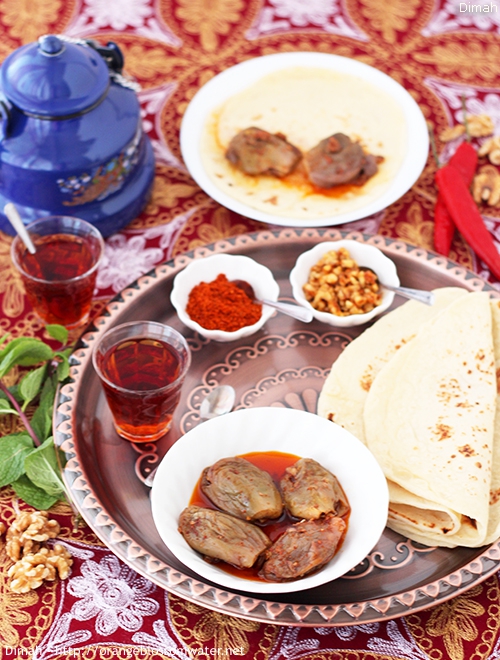
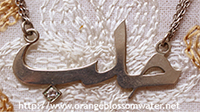
OMG I couldn’t have asked for more this week. I crave it so muh and my Syrian friends used to share it with me.. I was looking for a trusted recipe and there you are! I also tried your maamoul recipe and it was delicious. My blog is also orange blossom but with a french translation. That’s how I came to know about your website a few years back but I never got the chance to tell you that your work is just amazing!
Thank you very much for these explanations. They are clear to follow and make me try to cook all your recipes. Makdous is one of the most delicious meals I have never eaten.
My syrian and lebanese friends usually give me their homemade makdous, but this year, I will gift mine to them!
Best regards,